Day 56: Neck
Any rope safety guide will advise against tying the neck, yet rope along the neck keeps on being quite popular. If the risks of tampering with breathing and blood flow are high, many people seek its potential for pleasure. The neck is a very vulnerable part of the body, we can explore these sensations by going gently to find our own limits. Having a better understanding of the risks and mitigation strategy can help us make better choices in our play.
Neck anatomy
The neck ensures the mobility of the head and connects several vital organs. It is structured in four compartments:
- The vertebral compartment with the spine and postural muscles.
- The two vascular compartments with the carotid arteries, the internal jugular veins and the vagus nerve.
- The visceral compartment with the larynx, pharynx, trachea and several glands (thyroid, parathyroid, and thymus).
At the base of the mandible is the hyoid bone, the only bone of the body that is not connected to any other bone. This horseshoe-shaped bone serves as an attachment point to several muscles and more including the tongue, the floor of the mouth and the larynx. It plays a role in the tongue movement and swallowing mechanics. The main cause of hyoid bone fracture is strangulation and hanging. The consequence can go from mild discomfort to life-threatening respiratory distress.
The neck is protected by the spine and layers of muscle. The cervical vertebrae are the smallest of the spine. It is the most structural part of the neck but is vulnerable to shocks. The muscles of the neck are attached to the sternum, the clavicles, the hyoid bone and the skull forming triangles that allow the head to move in various angles and are involved in speech and swallowing. This structure makes the density of the muscle very different across the neck, leaving some parts more vulnerable than others.
The carotid arteries and the jugular veins run on each side of the neck. They are responsible for the blood flow to/from the brain and compressing these with rope can lead to brain damage and death. Baroreceptor nerves monitor the blood pressure in the arteries/veins. They do so by detecting stretching in the tissues and will signal for the heart to slow down if they detect blood pressure to be too high. We’ll dive deeper into these risks in the Choking and Risks section.
The larynx, pharynx, trachea are all important components of voice and respiration and mostly consist of cartilage. They are quite vulnerable to pressure and impact, and very slow at healing. Intubation or tracheostomy may be necessary procedures in case of heavy damage or obstruction.
This is only a summary of important anatomy information that relates to rope bondage. Check out the references for more details on neck anatomy.
Neck Muscles and Bondage Positions
When we stand straight or lie down, the muscles of the neck are passively engaged, but when we tie someone in an imbalanced position, they have to be active to hold their head in a comfortable position. For most people, the neck muscles will get sore very quickly. Some strategies may be to add something to hold the head or just change the position after a while.
[Coming soon, images of positions that makes it difficult for the neck]
We can reduce the risks of muscle injury by warming up the neck muscle ahead of time. Start with some gentle rotations in both directions, without leaning too much to the back. Then side to side, lateral flexions. And my favourite is called turtle and pigeon, which is moving the head forward, drawing a circle with the chin in both directions. A good warm-up will explore the natural range of motion and get the blood flowing in the muscles.
[Coming soon, images of neck warm-up]
In the long run, we can also strengthen the neck muscles with some exercises. For each of them, we want to start with the neck in a neutral position, with the spine aligned, the head pushed back above the shoulder. Strengthening the back for a better posture will also help the neck. Here are a few easy exercises:
- Isometrics: Use your hand or an elastic band to create an opposing force and push in all directions: forward, backward, left-right rotation, lateral flexion etc.
- Chin tuck: Lie on your back, and tuck your chin toward the neck. Hold for a few seconds. Repeat a few times.
- Lateral flexion: Lie on your side and flex the neck up and down. Repeat a few times.
- Wall push: For a bit more challenge, lean against the wall, and push your neck to the back to straighten it up using the back of the head.
[Coming soon, images neck strengthening exercise]
Choking and Risks
We can learn more about the risks of choking with rope by looking at the use of choke in martial art, other combat sports and military techniques. Chokeholds can cause fainting in an average of 9 seconds. It will lead to unconsciousness and death if the hold is maintained.
Air choke compresses the upper airway and will lead to asphyxia. It is less effective as a choke, causes pain and air hunger, and presents a risk of fractures to the larynx and hyoid bone.
Blood choke or sleeper hold, compress one or both carotid arteries and/or the jugular veins, and require very little strength. It causes cerebral ischemia and a temporary hypoxic condition in the brain. The mechanics of blood choke are not fully understood. The main theory is that baroreceptors detect stretching in the artery/vein, falsely detecting an increase in blood pressure, then sending the message to the body to slow down. If released immediately, it can cause unconsciousness for 10-20 seconds. But if the hold is maintained beyond 20 seconds, it can cause injury or death. Examples of injury include short-term memory loss, damage to the retina, hemorrhage, permanent brain damage, stroke, seizures, or coma.
In case of fainting, place the person on the ground in the recovery position and contact medical emergency services if the person doesn’t wake up within a few seconds. See Day 55.
The wide use of choking in different fields shows that if released immediately, there are little to no long term consequences on a healthy adult, but it might be different from someone with a heart or blood pressure condition, or younger people where the nervous system and heart development has not completed. Neck problems caused by the impact of the choke is a common injury from choking in martial art.
Another important aspect of choking is consent. Non Consensual choking can be a very traumatic experience, and many people have triggers related to the neck. It is important to be fully aware of the risks to give informed consent. Even with consent, if something serious happens, the law will still hold the person inflicting the choking responsible. Good communication, going slowly, and taking breaks for check-in are great ways to mitigate these risks.
A big difference between the chokehold and neck rope play is that releasing is not instantaneous. Any rope that is fixed in place, or that might tangle up represents an immense risk considering only a few seconds of choking can lead to death. Having a cutting tool ready on yourself may help, but unless you have a single strand of rope to cut, it will take more than a few seconds, especially if the person is unconscious. Using quick release (Day 9 – Day 217) and exploding knots (Day 224) may be a faster alternative, but they aren’t completely safe as they still require time to untie, and may tangle or collapse in the process.
Of course, none of these mitigation strategies work if you are alone. Fainting can happen very quickly and if the restriction is not immediately removed by a spotter, the irreversible is highly likely to happen. A safety call or video monitoring will not be able to get help fast enough. Solo neck rope is the highest cause of bondage death every year, please be safe.
Sudden pressure or shock is also something to be mindful of when playing with the neck. Unexpected movement can create instant damage on the more fragile part of the neck, especially the cartilage in the front and the hyoid bone. This is more likely to happen if a rope connects the neck to something else, such as another part of the body, or a hardpoint.
That said, not all rope touching the neck will cause an immediate choke. Businessmen can wear ties all day without fainting. The location of pressure and how much tension is involved will change how long it will take before reaching the point with real consequences. How many parts of the neck are compressed at the same time will also make a difference. If blood circulation is tampered with on one side, but the other side remains free, the brain will not be fully deprived of circulation. Hypoxic condition in the brain and fainting may still occur but at a much slower pace.
Not all choking in rope bondage comes from rope directly on the neck, it can be from a partner’s touch or even the body of the person being tied pressing against their own neck. We’ll see some of these positions in Day 111 and Day 349.
[Coming soon, pictures of neck quick release, asymmetric pressure, indirect choking]
Playing with the Neck
Let’s mention it again, the risks of playing with the neck include death, permanent injury to the brain and to the neck itself. That said, the likelihood of those risks with gentle pressure on the neck is quite low.
We can start by exploring our own neck with our fingers, gently pressing the different parts. Feel how the front and side of the neck require very little pressure to feel discomfort, and how the top part under the mandible, the base of the neck and the back are a bit more protected by muscles. We can put a finger in the little dip at the base of the neck in the front which is a very vulnerable spot. Try to engage the neck muscle to feel the difference and notice how this can protect the neck.
Using rope as an extension of your hand is a great way to use rope on the neck in a controlled way. We should be putting less pressure than we would be comfortable putting with our own hands as we don’t have the same level of feedback and control. Holding a piece of rope with two hands and using the part in between to caress the skin can be very erotic, and plays with the vulnerability of the body.
From there, should you want to explore with adding more pressure, and/or wrapping fully around the neck, you enter more dangerous territory. Make sure to discuss the plan with your partner, avoid the danger zone, stay in control, always have a way out that can be executed in seconds. Take breaks to check in on each other, and explore very progressively.
[Coming soon, picture gentle rope play with the neck]
Practice Time!
You can start exploring neck restriction with just your hands at first to get a precise understanding of what feels good and what is too strong. Fold a rope to have a large band of 4-8 ropes and use it as an extension of your hand to caress the neck and progressively increase intensity. Avoid using knots so you can remove the rope at any time.
Exploration ideas
- Explore your neck, and your partner’s neck with gentle touching with your fingers, hands.
- Try drawing the important parts on the neck such as the spine, muscles, veins, arteries, hyoid bone, larynx etc.
- Compare the effect when putting the rope at the base of the neck near the collar bones vs higher close to the chin.
- Touching with a rope, compare the sensations on the front vs on the back, vs on the side.
- How different is the sensation between a single rope, and several ropes touching the neck at the same time?
- Engage the neck muscles, how does that change the experience?
Solo variation
- Beyond gentle touching, do not explore this alone! You can still self-tie and have someone look over you as a spotter.
Inspirations and Resources
- The Neck Thing (TNT) by Neuromancer
- Dangerous by Nawakiri Shin (incident report)
- Neck on Healthline (try the layer slider)
- Neck anatomy by Jana Vasković
- How To Strengthen Neck Muscles At Home by Tone and Tighten
- Neck Strengthening Exercises by Bob & Brad
- Neck Strengthening Exercises by Doctor Jo
- Organisation of the Neck by AnatomyZone Part 1 Part 2
- Chokehold on Wikipedia
- Hyoid Bone Fracture: Associated With Head and Neck Trauma—A Rare Case Report by R. Keerthi and Abdulhaseeb Quadricorresponding
- Recovery position by HarmReductionWorks
Credit:

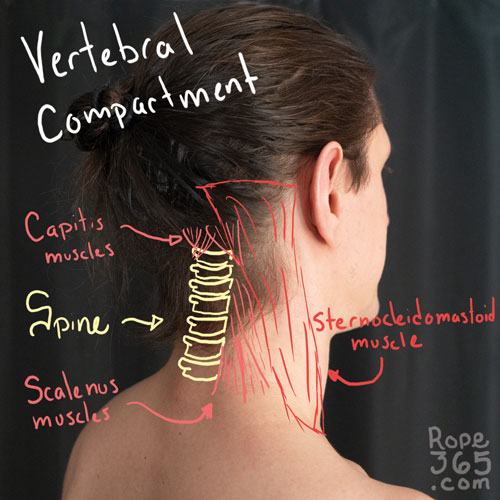
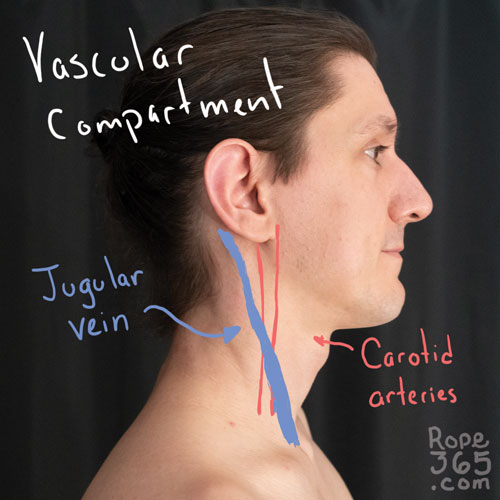
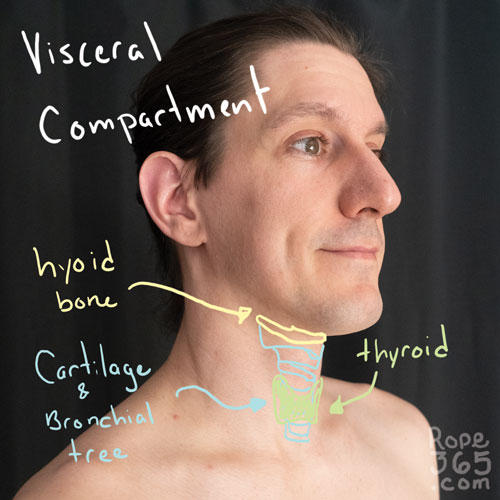
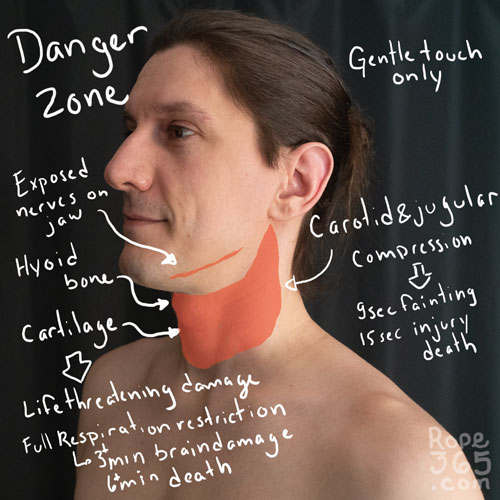
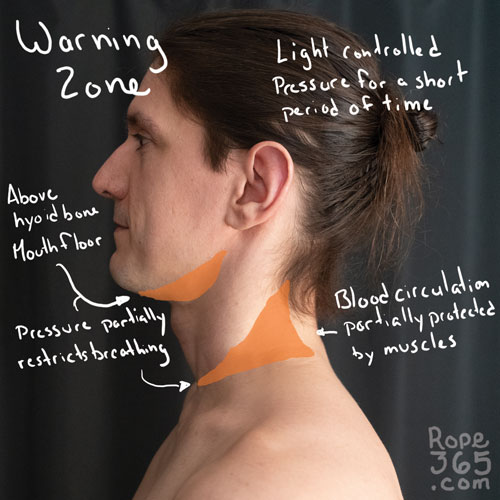
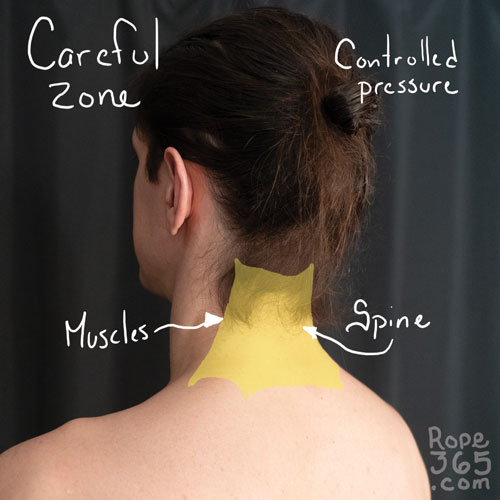
Leave a Reply